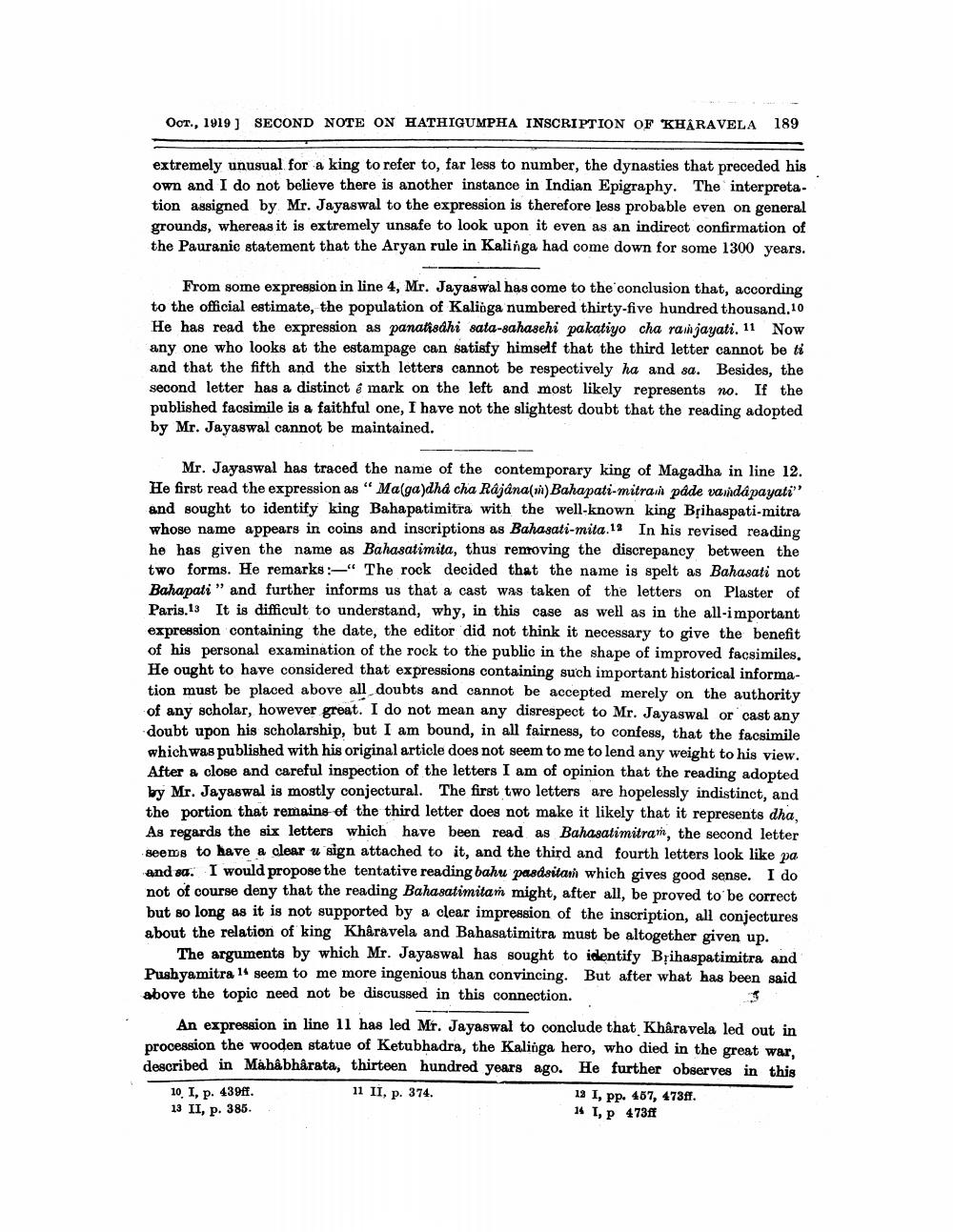________________
Oor., 1919 ) SECOND NOTE ON HATHIGUMPHA INSCRIPTION OF KHARAVELA 189
extremely unusual for a king to refer to, far less to number, the dynasties that preceded his own and I do not believe there is another instance in Indian Epigraphy. The interpretation assigned by Mr. Jayaswal to the expression is therefore less probable even on general grounds, whereas it is extremely unsafe to look upon it even as an indirect confirmation of the Pauranic statement that the Aryan rule in Kalinga had come down for some 1300 years.
From some expression in line 4, Mr. Jayaswal has come to the conclusion that, according to the official estimate, the population of Kalinga numbered thirty-five hundred thousand. 10 He has read the expression as panatisáhi sata-sahasehi pakatiyo cha ranjayati. 11 Now any one who looks at the estampage can satisfy himself that the third letter cannot be ti and that the fifth and the sixth letters cannot be respectively ha and sa. Besides, the second letter has a distinct é mark on the left and most likely represents no. If the published facsimile is a faithful one, I have not the slightest doubt that the reading adopted by Mr. Jayaswal cannot be maintained.
Mr. Jayaswal has traced the name of the contemporary king of Magadha in line 12. He first read the expression as " Ma(ga)dhá cha Rajana() Bahapati-mitrail páde vandâ payati” and sought to identify king Bahapatimitra with the well-known king Bțihaspati-mitra whose name appears in coins and inscriptions as Bahasati-mita 11 In his revised reading he has given the name as Bahasatimita, thus removing the discrepancy between the two forms. He remarks :-" The rock decided that the name is spelt as Bahasati not Bahapati" and further informs us that a cast was taken of the letters on Plaster of Paris.13 It is difficult to understand, why, in this case as well as in the all-important expression containing the date, the editor did not think it necessary to give the benefit of his personal examination of the rock to the public in the shape of improved facsimiles, He ought to have considered that expressions containing such important historical information must be placed above all doubts and cannot be accepted merely on the authority of any scholar, however great. I do not mean any disrespect to Mr. Jayaswal or cast any doubt upon his scholarship, but I am bound, in all fairness, to confess, that the facsimile which was published with his original article does not seem to me to lend any weight to his view. After a close and careful inspection of the letters I am of opinion that the reading adopted by Mr. Jayaswal is mostly conjectural. The first two letters are hopelessly indistinct, and the portion that remains of the third letter does not make it likely that it represents dha, As regards the six letters which have been read as Bahasatimitram, the second letter seems to have a clear u sign attached to it, and the third and fourth letters look like pa and sa. I would propose the tentative reading bahu pasdsitan which gives good sense. I do not of course deny that the reading Bahasatimitam might, after all, be proved to be correct but so long as it is not supported by a clear impression of the inscription, all conjectures about the relation of king Khâravela and Bahasatimitra must be altogether given up.
The arguments by which Mr. Jayaswal has sought to identify Brihaspatimitra and Pushyamitra 15 seem to me more ingenious than convincing. But after what has been said above the topic need not be discussed in this connection.
An expression in line 11 has led Mr. Jayaswal to conclude that Khâra vela led out in procession the wooden statue of Ketubhadra, the Kalinga hero, who died in the great war, described in Mahâbhârata, thirteen hundred years ago. He further observes in this 10. I, p. 439ff. 11 II, p. 374.
13 I, pp. 457, 473ff. 13 II, p. 385.
14 I, 473ff




